Resourceful Utilization of Cow Hair in the Preparation of Iron Tailing-Based Foam Concrete
Abstract
:1. Introduction
2. Materials and Methods
2.1. Materials
2.2. Mixtures and Methods
2.3. Characterization
2.3.1. Apparent Density
2.3.2. Compressive Strength
2.3.3. Flexural Strength
2.3.4. Stomatal Structure
2.3.5. Porosity
3. Results and Discussion
3.1. Raw Material Analysis
3.1.1. Cow Hair Fiber (CHF)
3.1.2. Iron Tailings
3.1.3. Stomatal Structure
- (1)
- Overview of Pore Structure
- (2)
- Porosity
- (3)
- Average pore size
- (4)
- Roundness value
3.2. Influence of the Content of CHF
3.2.1. Apparent Density
3.2.2. Compressive Strength
3.2.3. Flexural Strength
4. Conclusions
- Compared with the blank control group, all foamed concretes incorporating CHF showed higher compressive strength, flexural strength, and crack resistance, proving that CHF can improve the mechanical properties of foamed concrete. The compressive strength of the specimen reached a maximum value of 11.19 MPa when the CHF content was 0.2 wt%; the flexural strength reached a maximum value of 3.58 MPa when the CHF content was 0.15 wt%; and the fold-to-compression ratio reached a maximum value of 0.335 when the CHF content was 0.2 wt%.
- With the gradual increase in CHF content, the porosity of the foamed concrete continued to decrease. When the CHF content was 0.2 wt%, the average pore diameter and pore roundness of the specimens decreased to minimum values of 1.92 mm and 1.08, respectively.
- After a comprehensive analysis of the mechanical properties of foam concrete, it was found that, when the CHF content was 0.2 wt%, the foam concrete had the best mechanical properties; the compressive strength of the specimen was 11.19 MPa (an increase of 68.37%), the flexural strength was 3.36 MPa (increased by 50%), and the fold-to-compression ratio was 0.335 (increased by 8.06%). At the same time, after a comprehensive analysis of the characteristic parameters of the pore structure of the foamed concrete, it was found that the specimen had the most stable pore structure in the range of CHF contents ranging from 0.2 wt% to 0.3 wt%. Within this dosage range, the pores in the foam concrete were evenly distributed and uniform in size, and the stable pore wall structure also provided good mechanical properties of the specimen.
Author Contributions
Funding
Institutional Review Board Statement
Informed Consent Statement
Data Availability Statement
Conflicts of Interest
References
- Jhatial, A.A.; Goh, W.I.; Mohamad, N.; Rind, T.A.; Sandhu, A.R. Development of Thermal Insulating Lightweight Foamed Concrete Reinforced with Polypropylene Fibres. Arab. J. Sci. Eng. 2020, 45, 4067–4076. [Google Scholar] [CrossRef]
- Ayub, T.; Shafiq, N.; Nuruddin, M.F. Mechanical Properties of High-Performance Concrete Reinforced with Basalt Fibers. Procedia Eng. 2014, 77, 131–139. [Google Scholar] [CrossRef]
- Rashid, K.; Balouch, N. Influence of Steel Fibers Extracted from Waste Tires on Shear Behavior of Reinforced Concrete Beams. Struct. Concr. 2017, 18, 589–596. [Google Scholar] [CrossRef]
- Pakravan, H.R.; Latifi, M.; Jamshidi, M. Hybrid Short Fiber Reinforcement System in Concrete: A Review. Constr. Build. Mater. 2017, 142, 280–294. [Google Scholar] [CrossRef]
- Okeh, C.A.; Begg, D.W.; Barnett, S.J.; Nanos, N. Behaviour of Hybrid Steel Fibre Reinforced Self Compacting Concrete Using Innovative Hooked-End Steel Fibres Under Tensile Stress. Constr. Build. Mater. 2019, 202, 753–761. [Google Scholar] [CrossRef]
- Domski, J.; Katzer, J.; Zakrzewski, M.; Ponikiewski, T. Comparison of the Mechanical Characteristics of Engineered and Waste Steel Fiber Used as Reinforcement for Concrete. J. Clean. Prod. 2017, 158, 18–28. [Google Scholar] [CrossRef]
- Awang, H.; Ahmad, M.H. Durability Properties of Foamed Concrete with Fiber Inclusion. Int. J. Civ. Struct. Constr. Archit. Eng. 2014, 8, 273–276. [Google Scholar]
- Awang, H.; Ahmad, M.H.; Al-Mulali, M.Z. Influence of Kenaf and Polypropylene Fibres on Mechanical and Durability Properties of Fibre Reinforced Lightweight Foamed Concrete. J. Eng. Sci. Technol. 2015, 10, 496–508. [Google Scholar]
- Gencel, O.; Nodehi, M.; Bayraktar, O.Y.; Kaplan, G.; Benli, A.; Gholampour, A.; Ozbakkaloglu, T. Basalt Fiber-Reinforced Foam Concrete Containing Silica Fume: An Experimental Study. Constr. Build. Mater. 2022, 326, 126861. [Google Scholar] [CrossRef]
- Wang, Y.; Liu, H.; Xi, C.; Dou, G.; Qian, L. Static Analysis of Properties of a Composite Slab Made from Steel Fibers and a Reinforced Foam Concrete. Mech. Compos. Mater. 2019, 55, 535–546. [Google Scholar] [CrossRef]
- Falliano, D.; De Domenico, D.; Ricciardi, G.; Gugliandolo, E. Compressive and Flexural Strength of Fiber-Reinforced Foamed Concrete: Effect of Fiber Content, Curing Conditions and Dry Density. Constr. Build. Mater. 2019, 198, 479–493. [Google Scholar] [CrossRef]
- Falliano, D.; De Domenico, D.; Ricciardi, G.; Gugliandolo, E. Improving the Flexural Capacity of Extrudable Foamed Concrete with Glass-Fiber Bi-Directional Grid Reinforcement: An Experimental Study. Compos. Struct. 2019, 209, 45–59. [Google Scholar] [CrossRef]
- Gencel, O.; Kazmi, S.M.S.; Munir, M.J.; Kaplan, G.; Bayraktar, O.Y.; Yarar, D.O.; Karimipour, A.; Ahmad, M.R. Influence of Bottom Ash and Polypropylene Fibers on The Physico-Mechanical, Durability and Thermal Performance of Foam Concrete: An Experimental Investigation. Constr. Build. Mater. 2021, 306, 124887. [Google Scholar] [CrossRef]
- Deng, G.; Yang, Y.; Zhou, Q.; Lei, Y.; Yue, L.; Yang, T. Lightweight and Broadband Electromagnetic Wave Absorbing Foamed Cement-Based Composites Incorporated with Hybrid Dielectric Fibers. Constr. Build. Mater. 2022, 327, 126931. [Google Scholar] [CrossRef]
- Ahmad, F.; Choi, H.S.; Park, M.K. A Review: Natural Fiber Composites Selection in View of Mechanical, Light Weight, And Economic Properties. Macromol. Mater. Eng. 2015, 300, 10–24. [Google Scholar] [CrossRef]
- Asim, M.; Uddin, G.M.; Jamshaid, H.; Raza, A.; Tahir, Z.U.R.; Hussain, U.; Satti, A.N.; Hayat, N.; Arafat, S.M. Comparative Experimental Investigation of Natural Fibers Reinforced Light Weight Concrete as Thermally Efficient Building Materials. J. Build. Eng. 2020, 31, 101411. [Google Scholar] [CrossRef]
- Pinto, J.; Paiva, A.; Varum, H.; Costa, A.; Cruz, D.; Pereira, S.; Fernandes, L.; Tavares, P.; Agarwal, J. Corn’s Cob as A Potential Ecological Thermal Insulation Material. Energy Build. 2011, 43, 1985–1990. [Google Scholar] [CrossRef]
- La Rosa, A.D.; Recca, A.; Gagliano, A.; Summerscales, J.; Latteri, A.; Cozzo, G.; Cicala, G. Environmental impacts and Thermal Insulation Performance of Innovative Composite Solutions for Building Applications. Constr. Build. Mater. 2014, 55, 406–414. [Google Scholar] [CrossRef]
- Sassoni, E.; Manzi, S.; Motori, A.; Montecchi, M.; Canti, M. Novel Sustainable Hemp-Based Composites for Application in the Building Industry: Physical, Thermal and Mechanical Characterization. Energy Build. 2014, 77, 219–226. [Google Scholar] [CrossRef]
- Ali, M.; Liu, A.; Sou, H.; Chouw, N. Mechanical and Dynamic Properties of Coconut Fibre Reinforced Concrete. Constr. Build. Mater. 2012, 30, 814–825. [Google Scholar] [CrossRef]
- Gencel, O.; Bayraktar, O.Y.; Kaplan, G.; Benli, A.; Martínez-Barrera, G.; Brostow, W.; Tek, M.; Bodur, B. Characteristics of Hemp Fibre Reinforced Foam Concretes with Fly Ash and Taguchi Optimization. Constr. Build. Mater. 2021, 294, 123607. [Google Scholar] [CrossRef]
- Zhang, Y.; Zhang, B.; Shan, Z. Preparation of Sound-Insulating Material Based on Discarded Cow Hair. J. Appl. Polym. Sci. 2018, 135, 46332. [Google Scholar] [CrossRef]
- Shavandi, A.; Silva, T.H.; Bekhit, A.A.; Bekhit, A.E.D.A. Keratin: Dissolution, Extraction and Biomedical Application. Biomater. Sci. 2017, 5, 1699–1735. [Google Scholar] [CrossRef] [PubMed]
- Gau, M.R.; Said, M.I.; Yuliati, F.N. Effect of Differences in Fermentation Process Methods of Cattle Hair Waste on the Properties of Hair Protein Concentrate. IOP Conf. Ser. Earth Environ. Sci 2021, 788, 012153. [Google Scholar] [CrossRef]
- Song, J.; Li, Y.; Wang, Y.; Zhong, L.; Liu, Y.; Sun, X.; He, B.; Li, Y.; Cao, S. Preparing Biochars from Cow Hair Waste Produced in a Tannery for Dye Wastewater Treatment. Materials 2021, 14, 1690. [Google Scholar] [CrossRef]
- She, W.; Du, Y.; Zhao, G.; Feng, P.; Zhang, Y.; Cao, X. Influence of Coarse Fly Ash on The Performance of Foam Concrete and Its Application in High-Speed Railway Roadbeds. Constr. Build. Mater. 2018, 170, 153–166. [Google Scholar] [CrossRef]
- Gökçe, H.S.; Hatungimana, D.; Ramyar, K. Effect of Fly Ash and Silica Fume on Hardened Properties of Foam Concrete. Constr. Build. Mater. 2019, 194, 1–11. [Google Scholar] [CrossRef]
- Chandni, T.J.; Anand, K.B. Utilization of Recycled Waste as Filler in Foam Concrete. J. Build. Eng. 2018, 19, 154–160. [Google Scholar] [CrossRef]
- Kashani, A.; Ngo, T.D.; Hajimohammadi, A. Effect of Recycled Glass Fines on Mechanical and Durability Properties of Concrete Foam in Comparison with Traditional Cementitious Fines. Cem. Concr. Compos. 2019, 99, 120–129. [Google Scholar] [CrossRef]
- Awang, H.; Aljoumaily, Z.S. Influence of Granulated Blast Furnace Slag on Mechanical Properties of Foam Concrete. Cogent Eng. 2017, 4, 1409853. [Google Scholar] [CrossRef]
- Zhao, X.; Lim, S.K.; Tan, C.S.; Li, B.; Ling, T.C.; Huang, R.; Wang, Q. Properties of Foamed Mortar Prepared with Granulated Blast-Furnace Slag. Materials 2015, 8, 462–473. [Google Scholar] [CrossRef] [PubMed]
- Esbati, S.; Amooie, M.A.; Sadeghzadeh, M.; Ahmadi, M.H.; Pourfayaz, F.; Ming, T. Investigating the Effect of Using PCM in Building Materials for Energy Saving Case Study of Sharif Energy Research Institute. Energy Sci. Eng. 2020, 8, 959–972. [Google Scholar] [CrossRef]
- Cui, Y.; Xie, J.; Liu, J.; Pan, S. Review of Phase Change Materials Integrated in Building Walls for Energy Saving. Procedia Eng. 2015, 121, 763–770. [Google Scholar] [CrossRef]
- Zhao, J.; Ni, K.; Su, Y.; Shi, Y. An Evaluation of Iron Ore Tailings Characteristics and Iron Ore Tailings Concrete Properties. Constr. Build. Mater. 2021, 286, 122968. [Google Scholar] [CrossRef]
- Kuranchie, F.A.; Shukla, S.K.; Habibi, D.; Mohyeddin, A. Utilisation of Iron Ore Tailings as Aggregates in Concrete. Cogent Eng. 2015, 2, 1083137. [Google Scholar] [CrossRef]
- Ismail, Z.Z.; Al-Hashmi, E.A. Reuse of Waste Iron as a Partial Replacement of Sand in Concrete. Waste Manag. 2008, 28, 2048–2053. [Google Scholar] [CrossRef]
- Kearsley, E.P.; Wainwright, P.J. The Effect of Porosity on the Strength of Foamed Concrete. Cem. Concr. Res. 2002, 32, 233–239. [Google Scholar] [CrossRef]
- Nguyen, T.T.; Bui, H.H.; Ngo, T.D.; Nguyen, G.D. Experimental and Numerical Investigation of Influence of Air-Voids on the Compressive Behaviour of Foamed Concrete. Mater. Des. 2017, 130, 103–119. [Google Scholar] [CrossRef]
- Nambiar, E.K.; Ramamurthy, K. Air-Void Characterisation of Foam Concrete. Cem. Concr. Res. 2007, 37, 221–230. [Google Scholar] [CrossRef]
- Sui, W.; Zhang, D. Four Methods for Roundness Evaluation. Phys. Procedia 2012, 24, 2159–2164. [Google Scholar] [CrossRef]
- Castillo-Lara, J.F.; Flores-Johnson, E.A.; Valadez-Gonzalez, A.; Herrera-Franco, P.J.; Carrillo, J.G.; Gonzalez-Chi, P.I.; Li, Q.M. Mechanical Properties of Natural Fiber Reinforced Foamed Concrete. Materials 2020, 13, 3060. [Google Scholar] [CrossRef] [PubMed]
- Mastali, M.; Kinnunen, P.; Isomoisio, H.; Karhu, M.; Illikainen, M. Mechanical and Acoustic Properties of Fiber-Reinforced Alkali-Activated Slag Foam Concretes Containing Lightweight Structural Aggregates. Constr. Build. Mater. 2018, 187, 371–381. [Google Scholar] [CrossRef]
- Yang, K.H.; Lee, K.H.; Song, J.K.; Gong, M.H. Properties and Sustainability of Alkali-Activated Slag Foamed Concrete. J. Clean. Prod. 2014, 68, 226–233. [Google Scholar] [CrossRef]
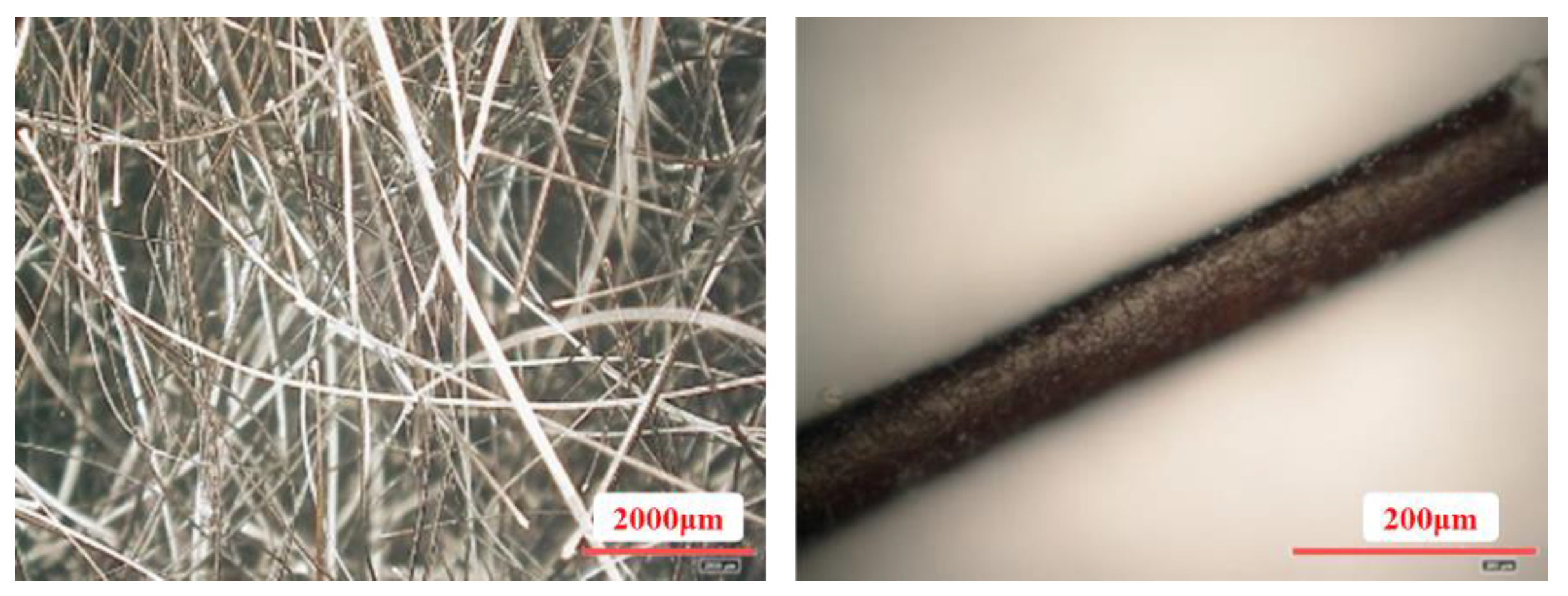
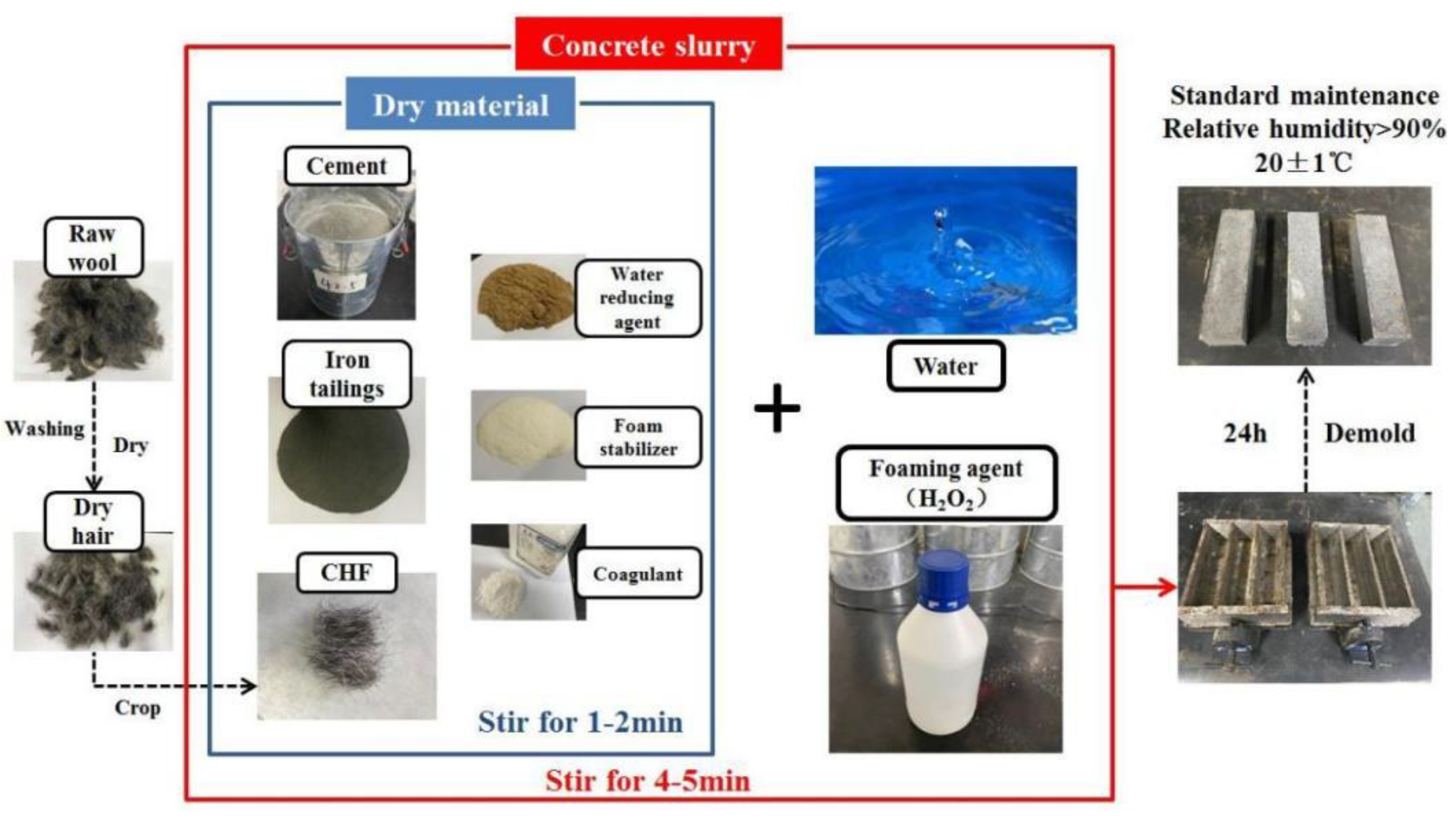
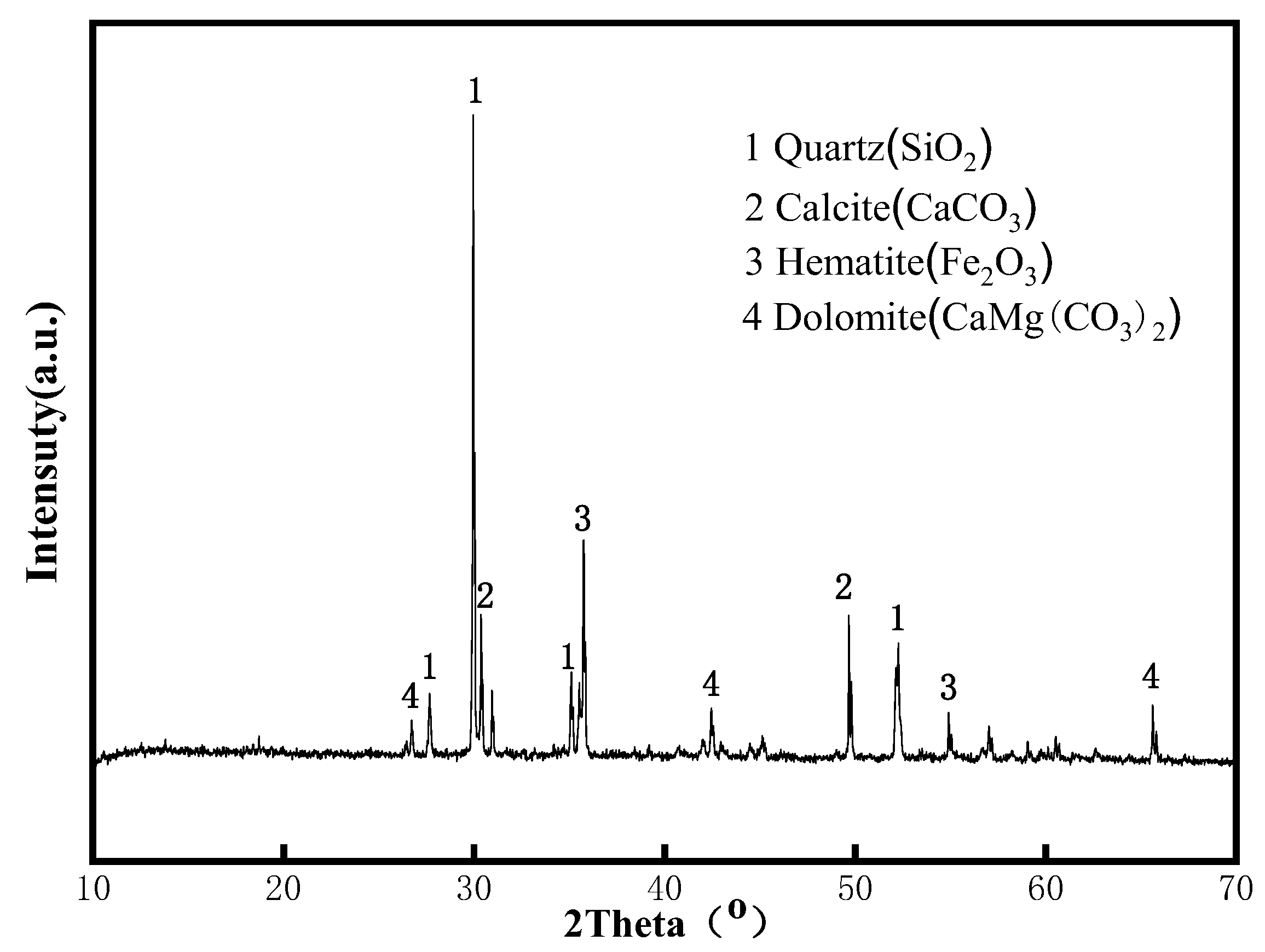
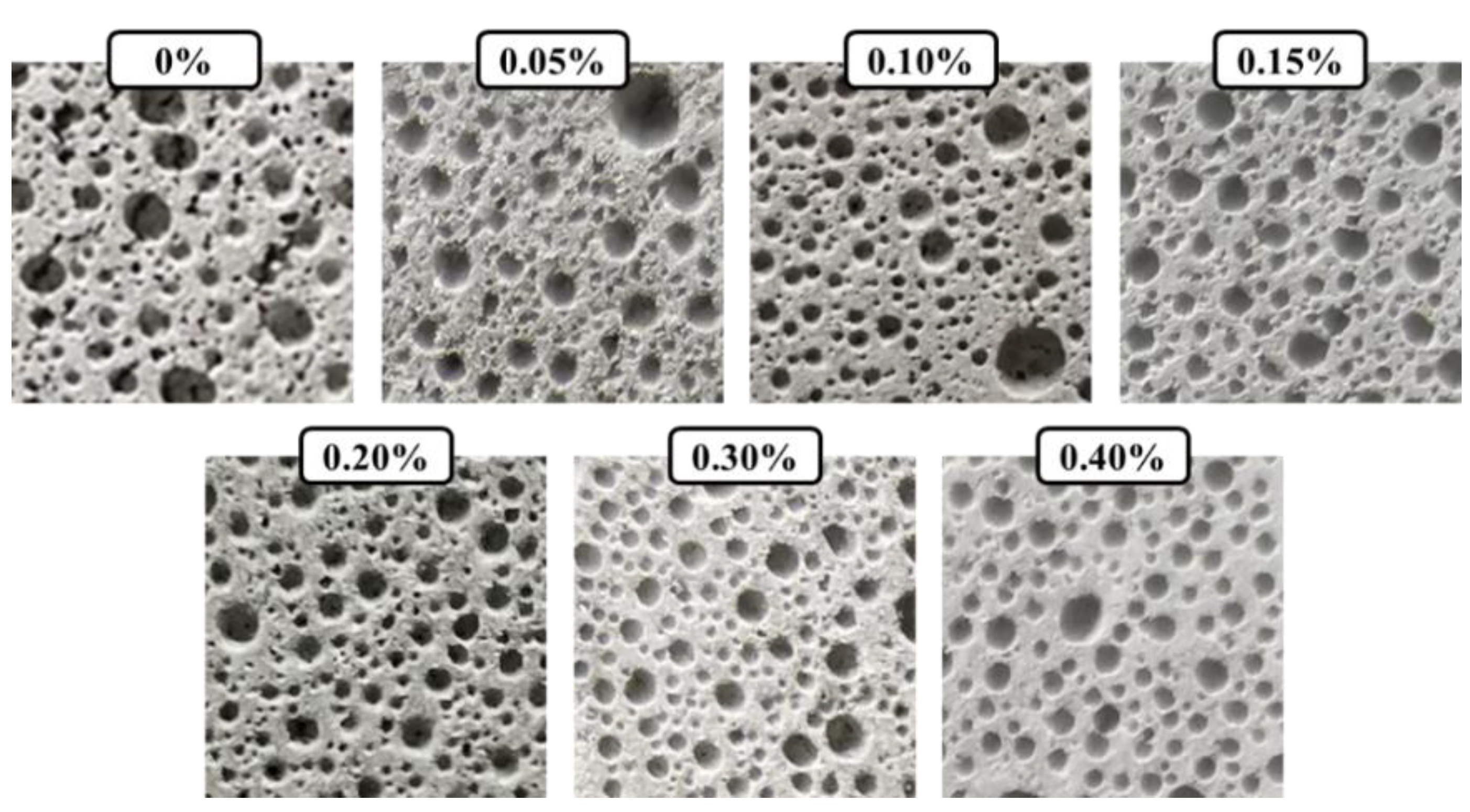
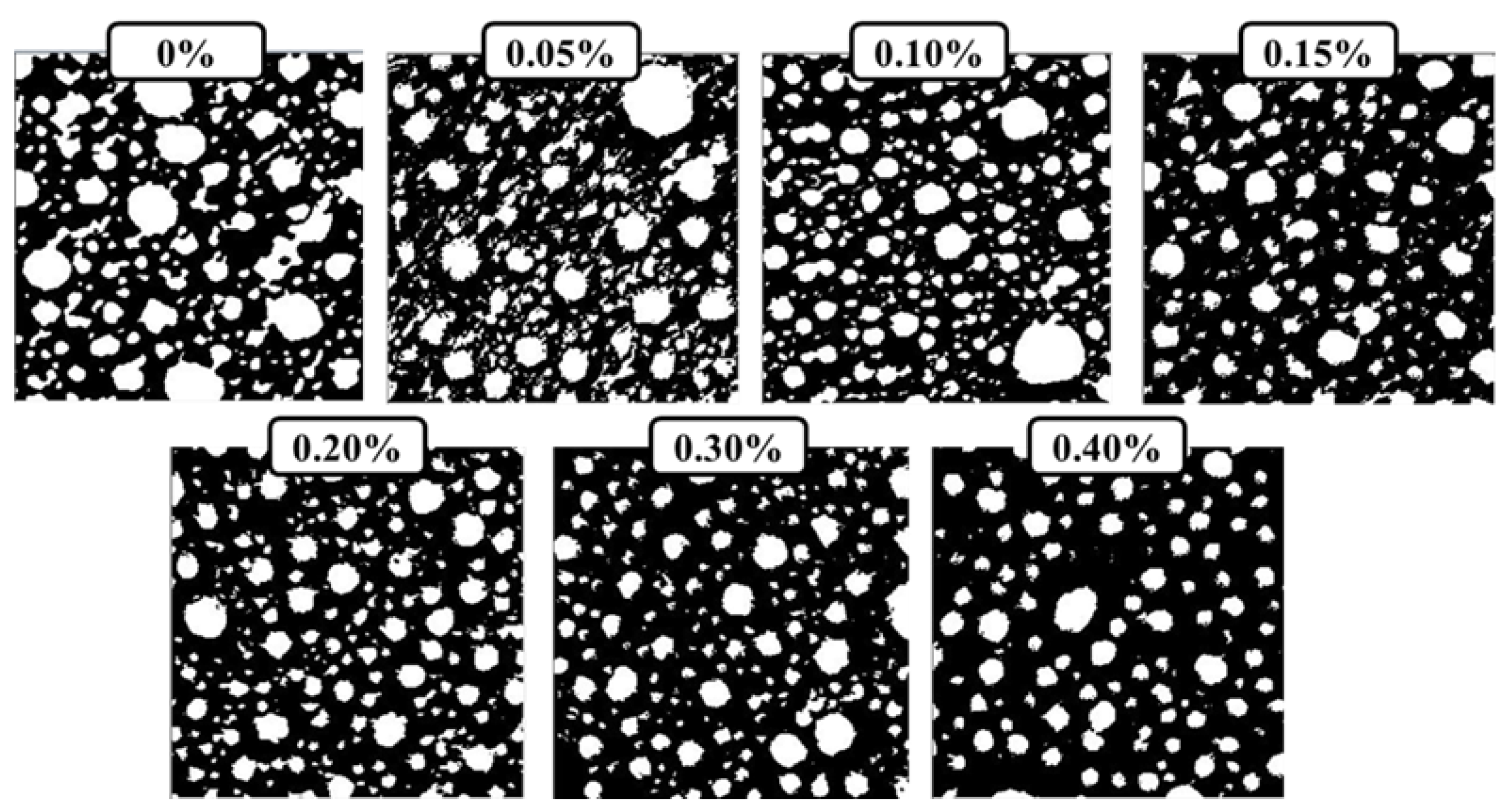
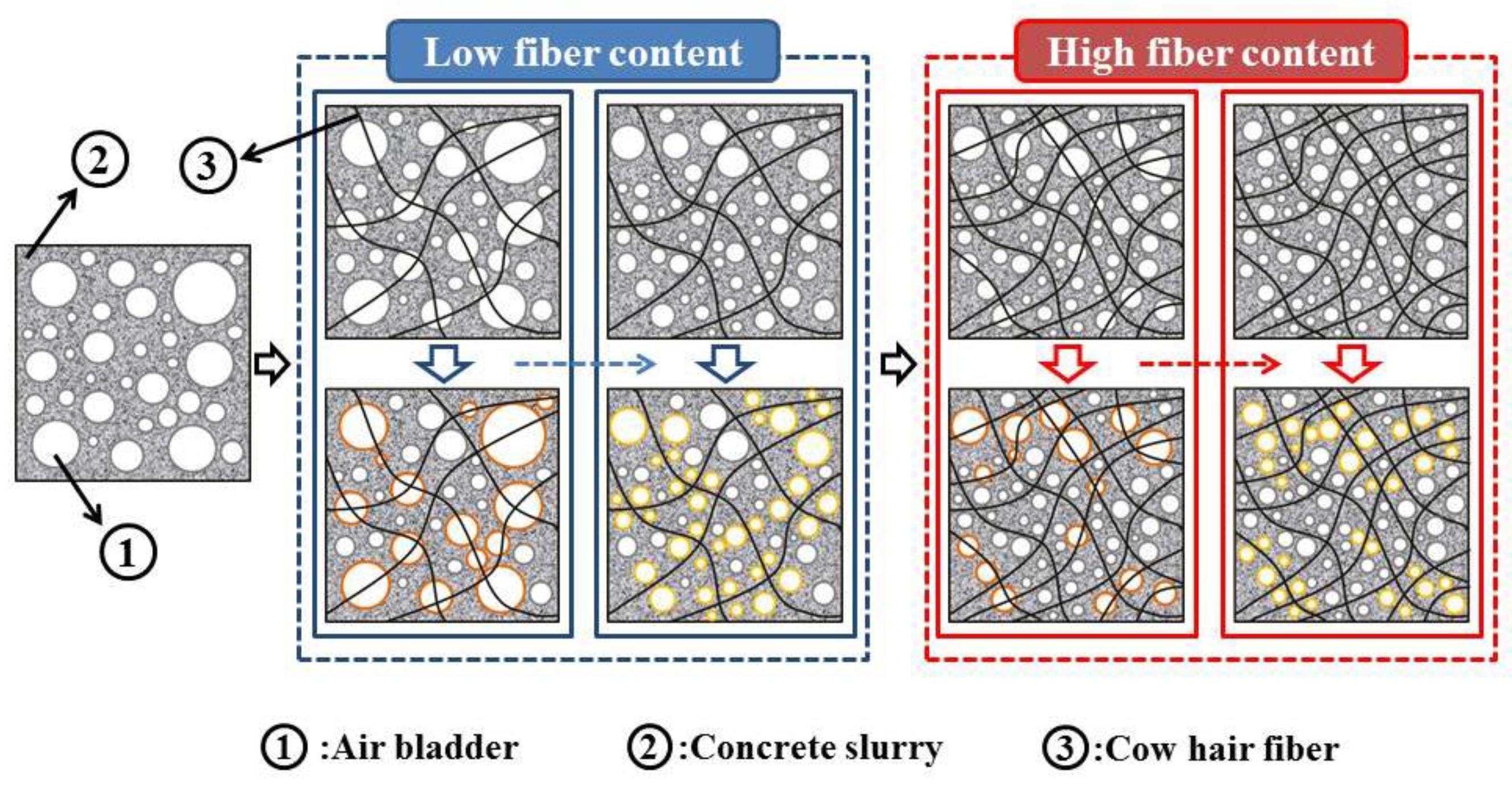
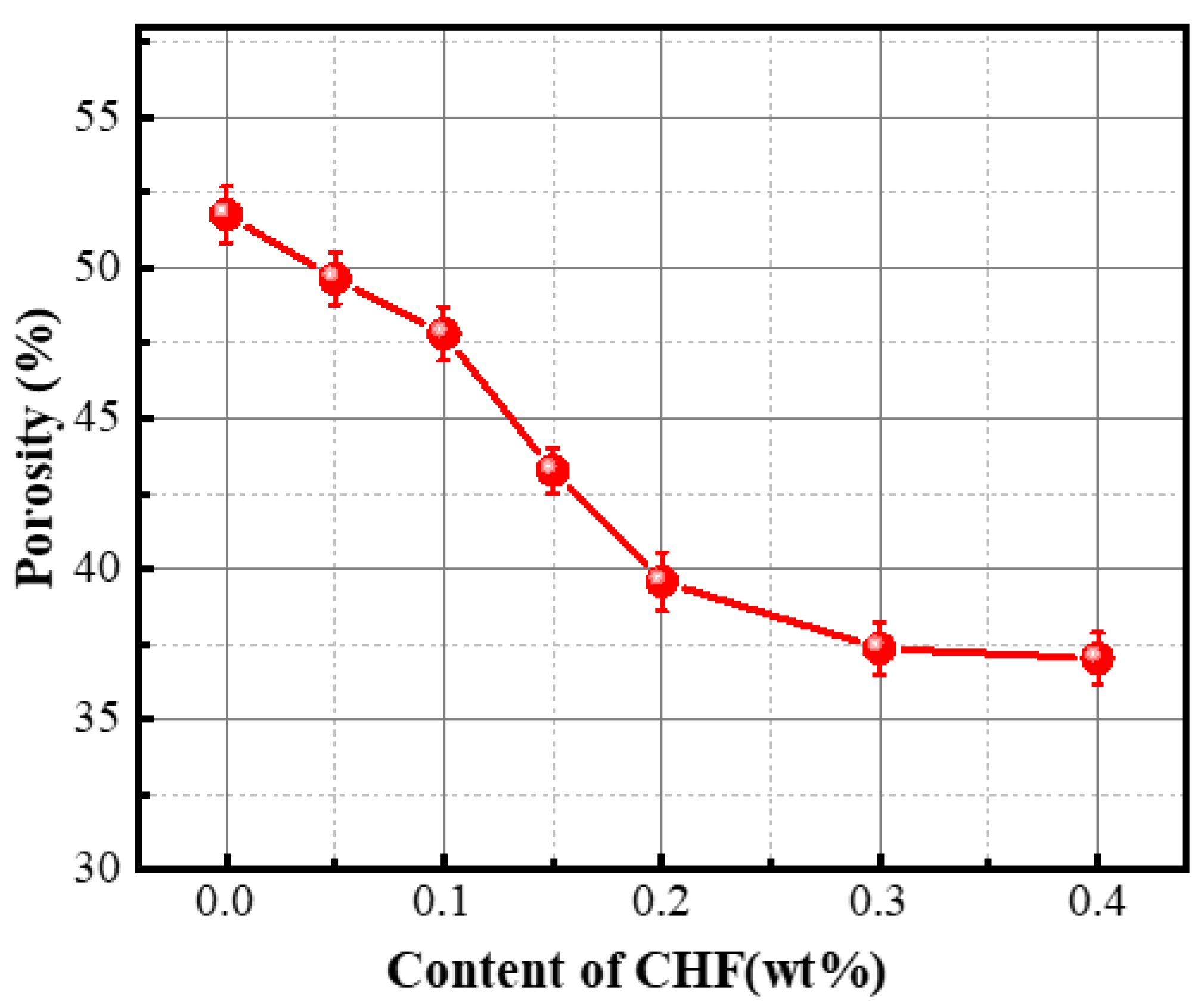
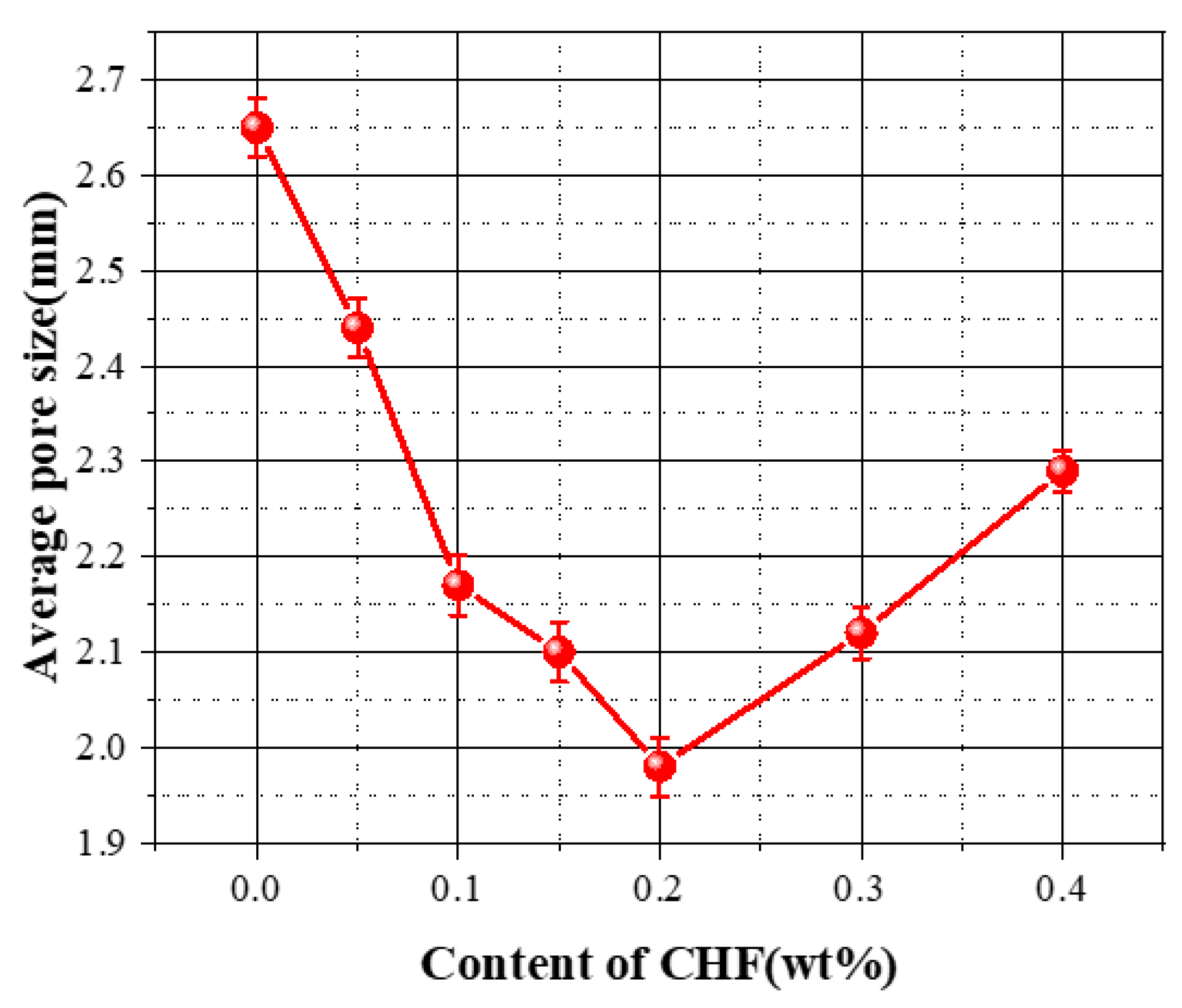
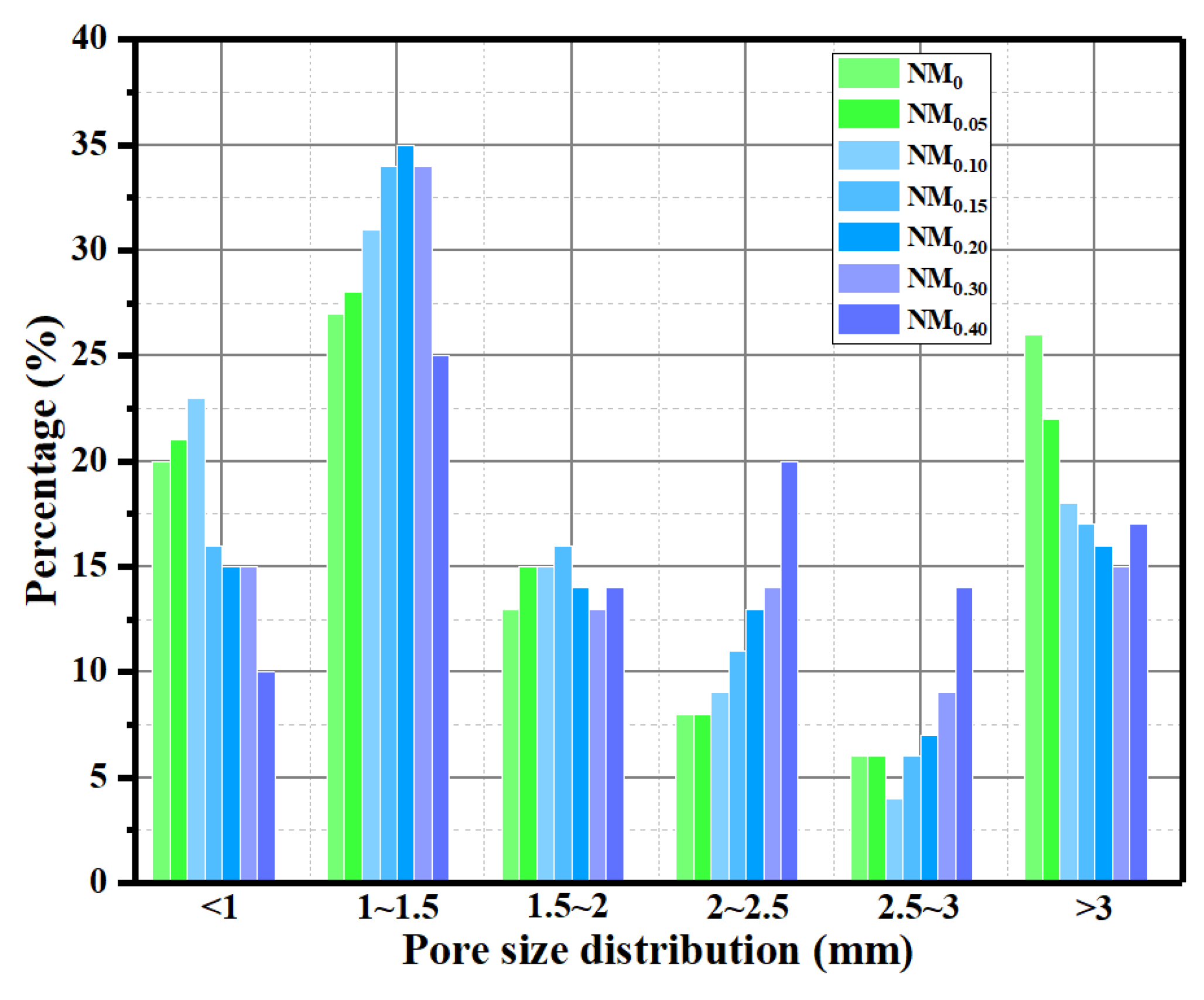
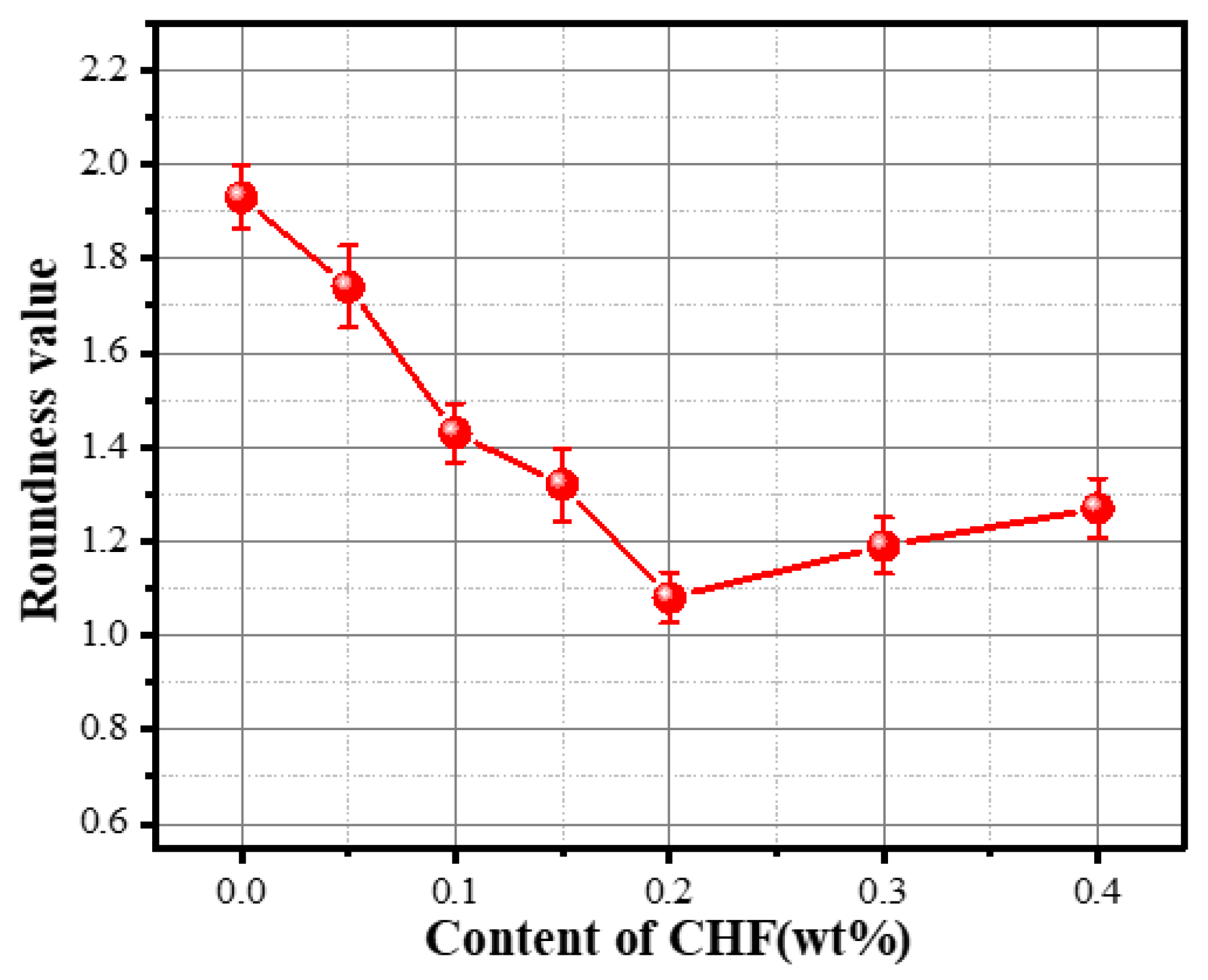
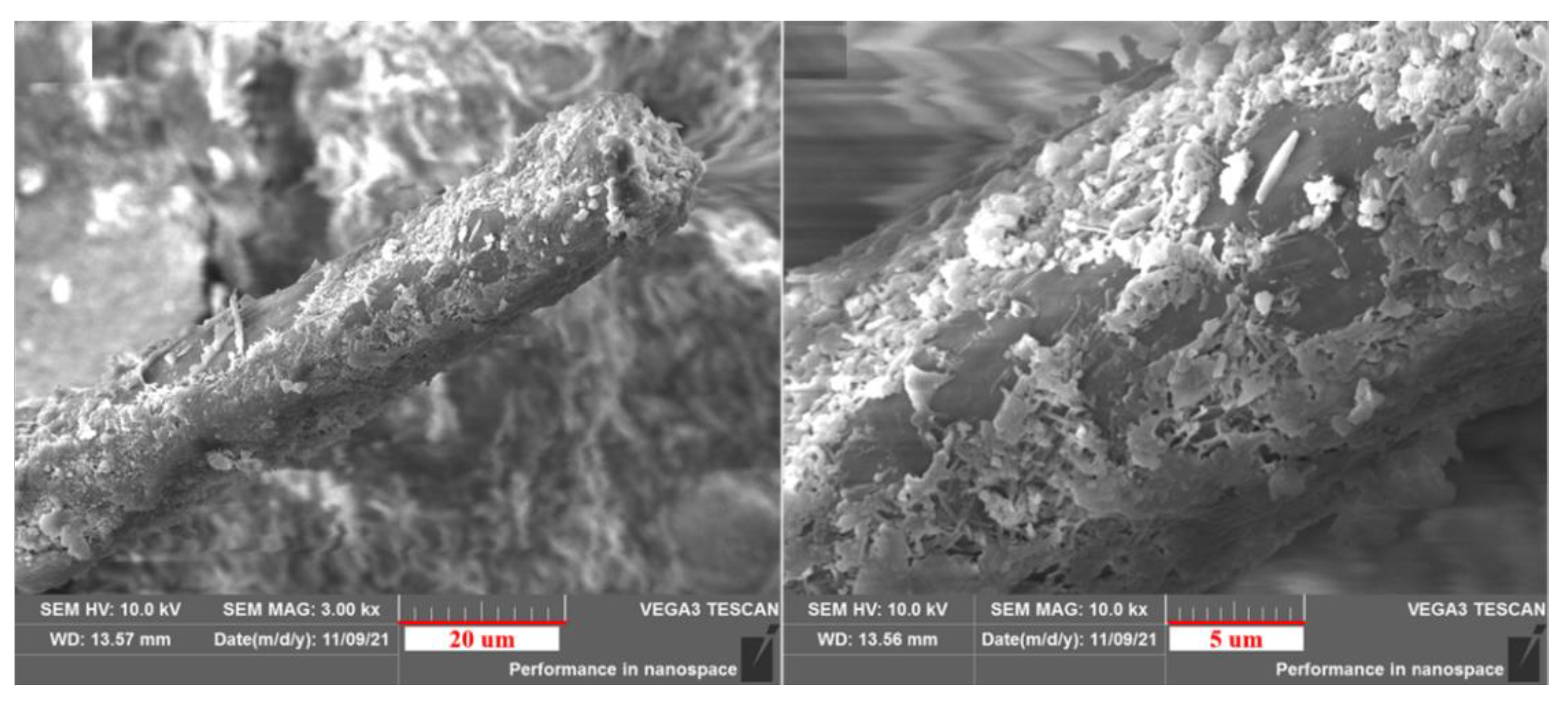


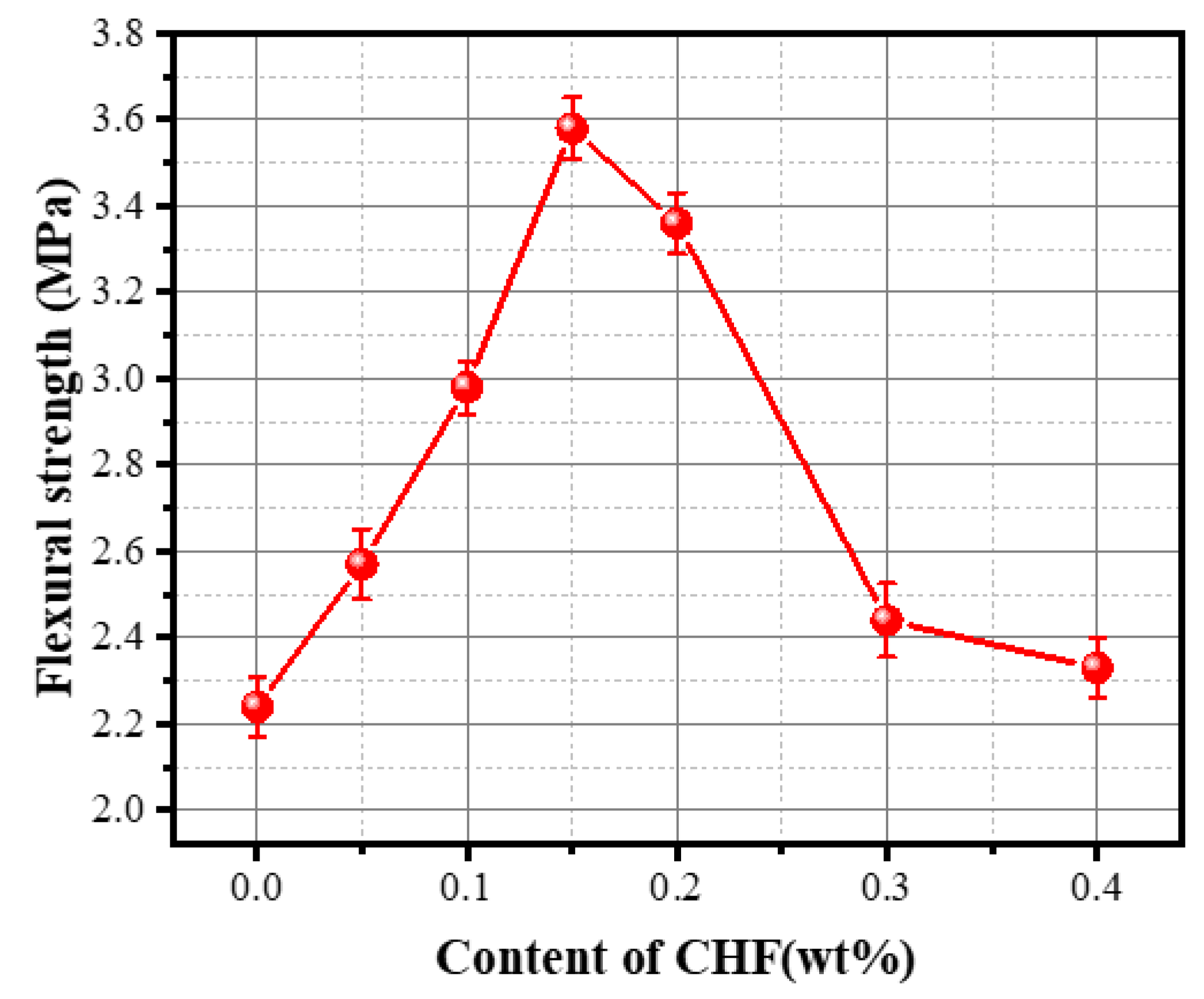
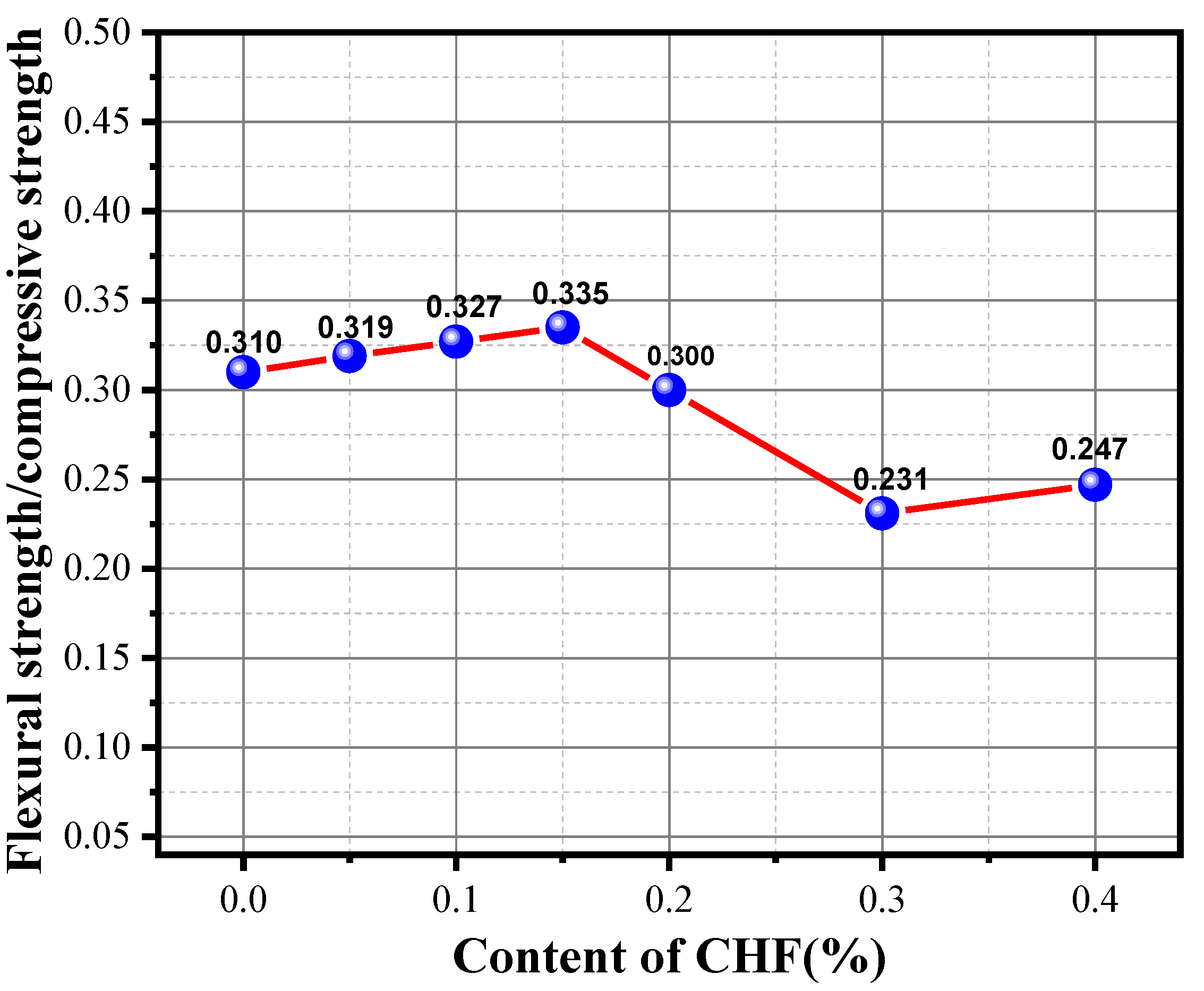
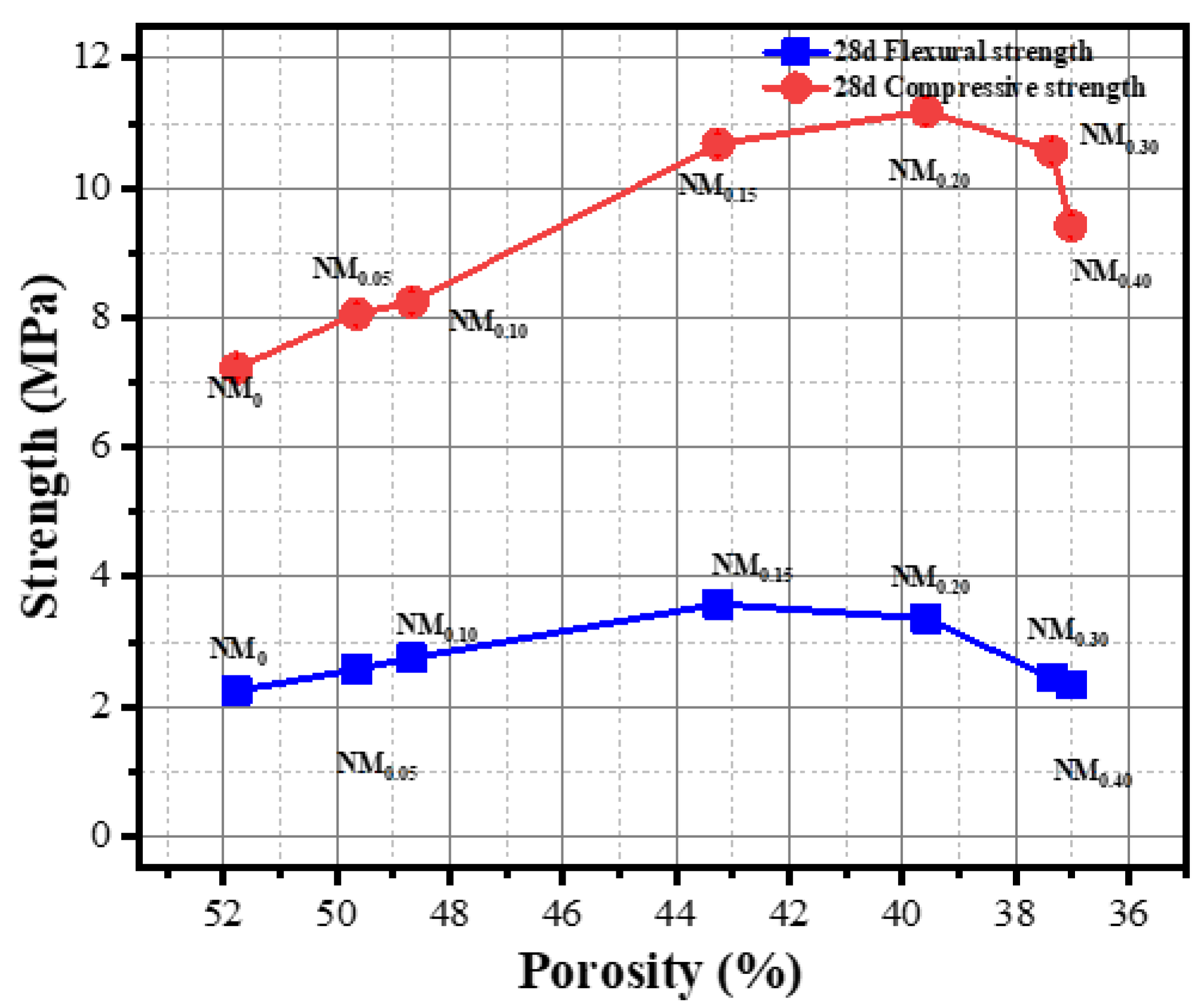
| ID | Cement/g | Iron Tailing/g | H2O2/g | CHF/g | Water/g |
|---|---|---|---|---|---|
| N0 | 450 | 150 | 11.25 | 0 | 225 |
| N0.05 | 450 | 150 | 11.25 | 0.3 | 225 |
| N0.1 | 450 | 150 | 11.25 | 0.6 | 225 |
| N0.15 | 450 | 150 | 11.25 | 0.9 | 225 |
| N0.2 | 450 | 150 | 11.25 | 1.2 | 225 |
| N0.3 | 450 | 150 | 11.25 | 1.8 | 225 |
| N0.4 | 450 | 150 | 11.25 | 2.4 | 225 |
| Diameter (μm) | Elastic Modulus (GPa) | Tensile Strength (MPa) | Elongation at Break (%) |
|---|---|---|---|
| 85–115 | 1.53–1.98 | 97–121 | 19.23–26.47 |
| IT | SiO2 | Al2O3 | Fe2O3 | CaO | MgO | K2O | Na2O | Mn2O3 | P2O5 | TiO2 |
|---|---|---|---|---|---|---|---|---|---|---|
| wt% | 42.92 | 4.64 | 15.04 | 20.29 | 11.99 | 0.32 | 3.13 | 0.2417 | 0.4124 | 1.0275 |
Publisher’s Note: MDPI stays neutral with regard to jurisdictional claims in published maps and institutional affiliations. |
© 2022 by the authors. Licensee MDPI, Basel, Switzerland. This article is an open access article distributed under the terms and conditions of the Creative Commons Attribution (CC BY) license (https://creativecommons.org/licenses/by/4.0/).
Share and Cite
Liu, L.; Yang, J.; She, Y.; Lv, S.; Yang, Z.; Zhang, J. Resourceful Utilization of Cow Hair in the Preparation of Iron Tailing-Based Foam Concrete. Materials 2022, 15, 5739. https://doi.org/10.3390/ma15165739
Liu L, Yang J, She Y, Lv S, Yang Z, Zhang J. Resourceful Utilization of Cow Hair in the Preparation of Iron Tailing-Based Foam Concrete. Materials. 2022; 15(16):5739. https://doi.org/10.3390/ma15165739
Chicago/Turabian StyleLiu, Leipeng, Junjie Yang, Yinfei She, Shenghua Lv, Zheng Yang, and Jia Zhang. 2022. "Resourceful Utilization of Cow Hair in the Preparation of Iron Tailing-Based Foam Concrete" Materials 15, no. 16: 5739. https://doi.org/10.3390/ma15165739





